CHEVROLET TRACKER 1997 Repair Manual
Manufacturer: CHEVROLET, Model Year: 1997, Model line: TRACKER, Model: CHEVROLET TRACKER 1997Pages: 388, PDF Size: 20.12 MB
Page 61 of 388
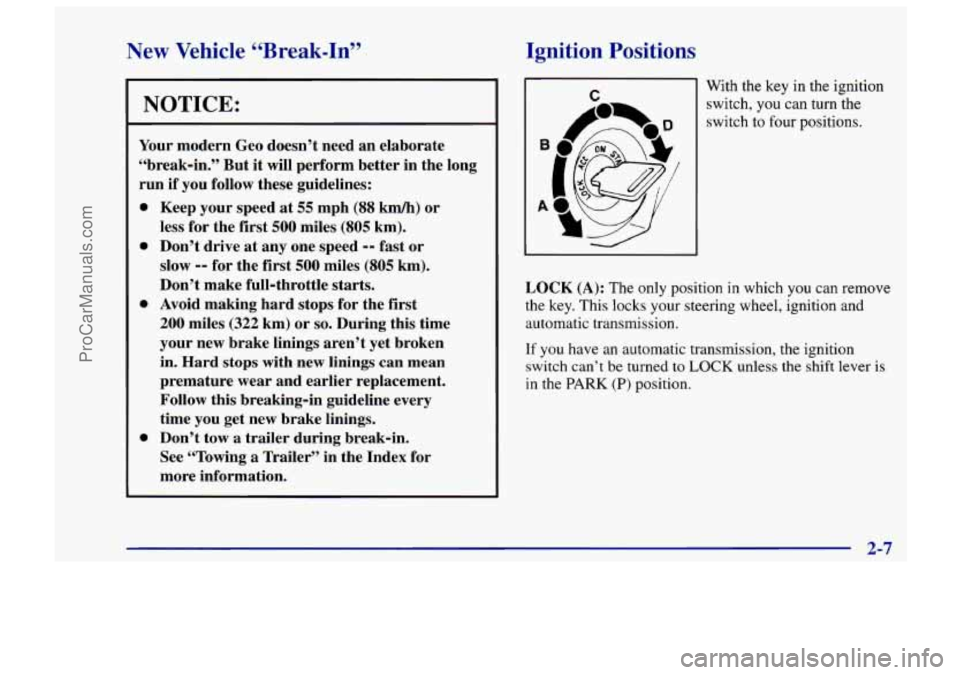
New Vehicle “Break-In” 1
NOTICE:
Your modern Geo doesn’t need an elaborate
“break-in.” But it will perform better in the long
run if you follow these guidelines:
0
0
0
0
Keep your speed at 55 mph (88 km/h) or
less for the first
500 miles (805 km).
Don’t drive at any one speed
-- fast or
slow
-- for the first 500 miles (805 km).
Don’t make full-throttle starts.
Avoid making hard stops for the first
200 miles (322 km) or so. During this time
your new brake linings aren’t yet broken
in. Hard stops
with new linings can mean
premature wear and earlier replacement.
Follow this breaking-in guideline every
time you get new brake linings.
Don’t tow
a trailer during break-in.
See “Towing
a Trailer” in the Index for
more information.
[gnition Positions
With the key in the ignition
switch, you can turn the
switch
to four positions.
LOCK (A): The only position in which you can remove
the key. This locks your steering wheel, ignition and
automatic transmission.
If you have an automatic transmission, the ignition
switch can’t be turned to
LOCK unless the shift lever is
in the PARK (P) position.
2-7
I
ProCarManuals.com
Page 62 of 388
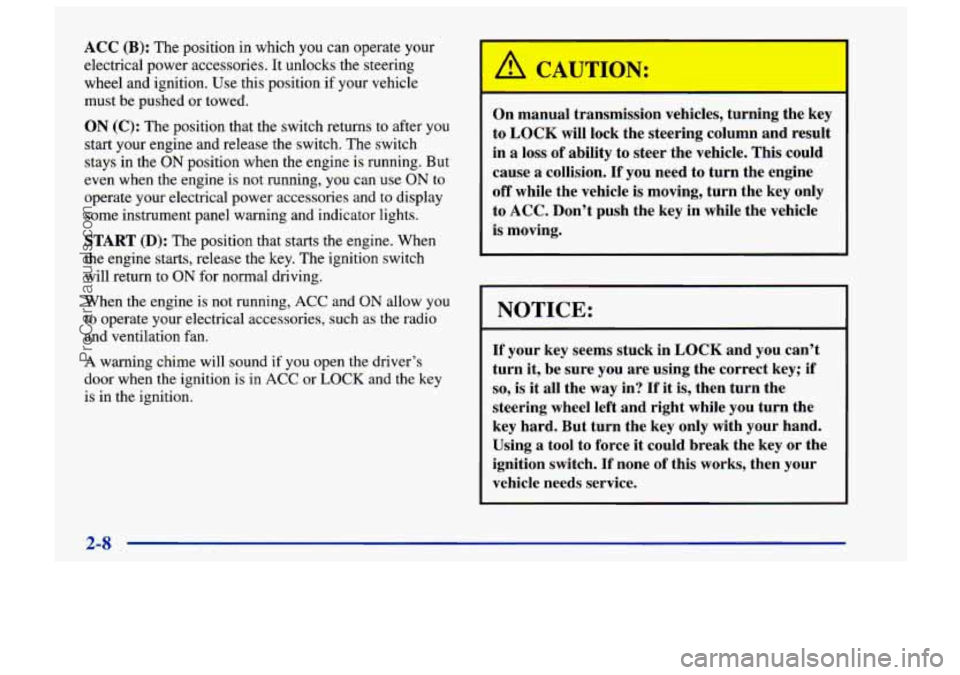
ACC (B): The position in which you can operate your
electrical power accessories. It unlocks the steering
wheel and ignition. Use this position if your vehicle
must
be pushed or towed.
ON (C): The position that the switch returns to after you
start your engine and release the switch. The switch
stays in the
ON position when the engine is running. But
even when the engine is not running, you can use
ON to
operate your electrical power accessories and to display
some instrument panel warning and indicator lights.
START (D): The position that starts the engine. When
the engine starts, release the key. The ignition switch
will return to
ON for normal driving.
When the engine is not running,
ACC and ON allow you
to operate your electrical accessories, such as the radio
and ventilation fan.
A warning chime will sound if you open the driver’s
door when the ignition is in
ACC or LOCK and the key
is in the ignition.
I A CAUTION:
On manual transmission vehicles, turning the key
to
LOCK will lock the steering column and result
in
a loss of ability to steer the vehicle. This could
cause
a collision. If you need to turn the engine
off while the vehicle is moving, turn the key only
to
ACC. Don’t push the key in while the vehicle
is moving.
I
NOTICE:
If your key seems stuck in LOCK and you can’t
turn it, be sure you are using the correct key; if
so, is it all the way in? If it is, then turn the
steering wheel left and right while you turn the
key hard. But turn the key only with your hand.
Using
a tool to force it could break the key or the
ignition switch. If none of this works, then your
vehicle needs service.
2-8
ProCarManuals.com
Page 63 of 388
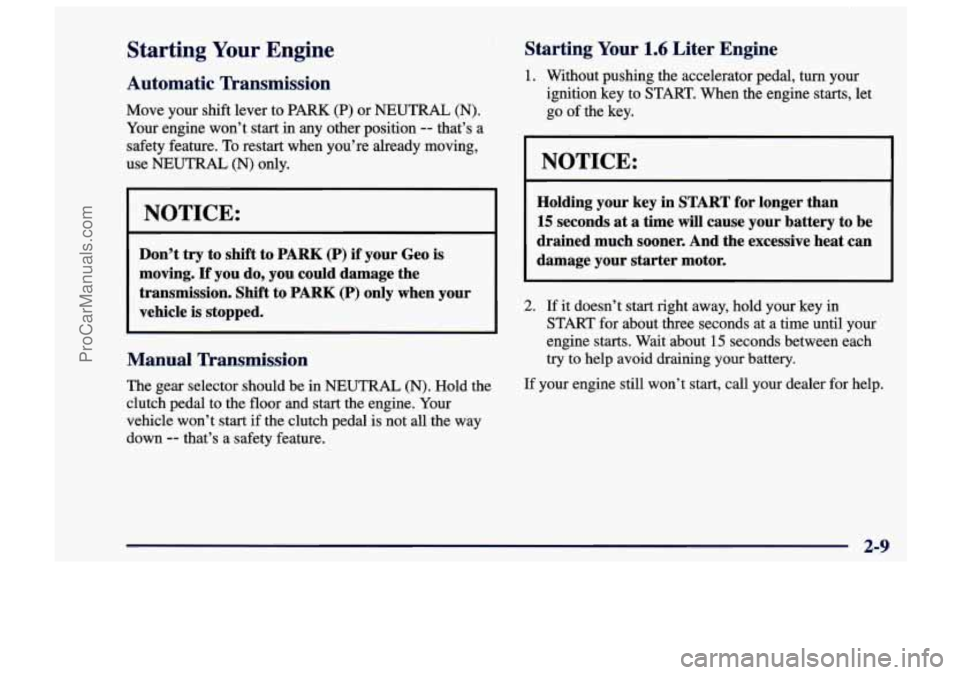
Starting Your Engine
Automatic Transmission
Move your shift lever to PARK (P) or NEUTRAL (N).
Your engine won’t start in any other position -- that’s a
safety feature.
To restart when you’re already moving,
use
NEUTRAL (N) only.
I NOTICE:
Don’t try to shift to PARK (P) if‘ your Geo is
moving.
If you do, you could damage the
transmission. Shift to PARK
(P) only when your
vehicle
is stopped.
Manual Transmission
The gear selector should be in NEUTRAL (N). Hold the
clutch pedal to the floor and start the engine. Your
vehicle won’t start if the clutch pedal
is not all the way
down
-- that’s a safety feature.
Starting Your 1.6 Liter Engine
1. Without pushing the accelerator pedal, turn your
ignition key to START. When the engine starts, let
go of the key.
I I
NOTICE:
Holding your key in START for longer than
15 seconds at a time will cause your battery to be
drained much sooner. And the excessive heat can
damage your starter motor.
2. If it doesn’t start right away, hold your key in
START for about three seconds at a time until your
engine starts. Wait about
15 seconds between each
try to help avoid draining your battery.
If your engine still won’t start. call vour dealer for help.
2-9
ProCarManuals.com
Page 64 of 388

NOTICE:
Your engine is designed to work with the
electronics
in your vehicle. If you add electrical
parts or accessories, you could change the
way
the engine operates. Before adding electrical
equipment, check with your dealer.
If you don’t,
your engine might not perform properly.
If you ever have to have your vehicle towed, see
the part
of this manual that tells how to do it
without damaging your vehicle. See “Towing
Your Vehicle” in the Index.
Automatic Transmission Operation
There are several different positions for your shift lever.
PARK (P): This locks your rear wheels. It’s the best
position
to use when you start your engine because your
vehicle can’t move easily.
2-10
ProCarManuals.com
Page 65 of 388
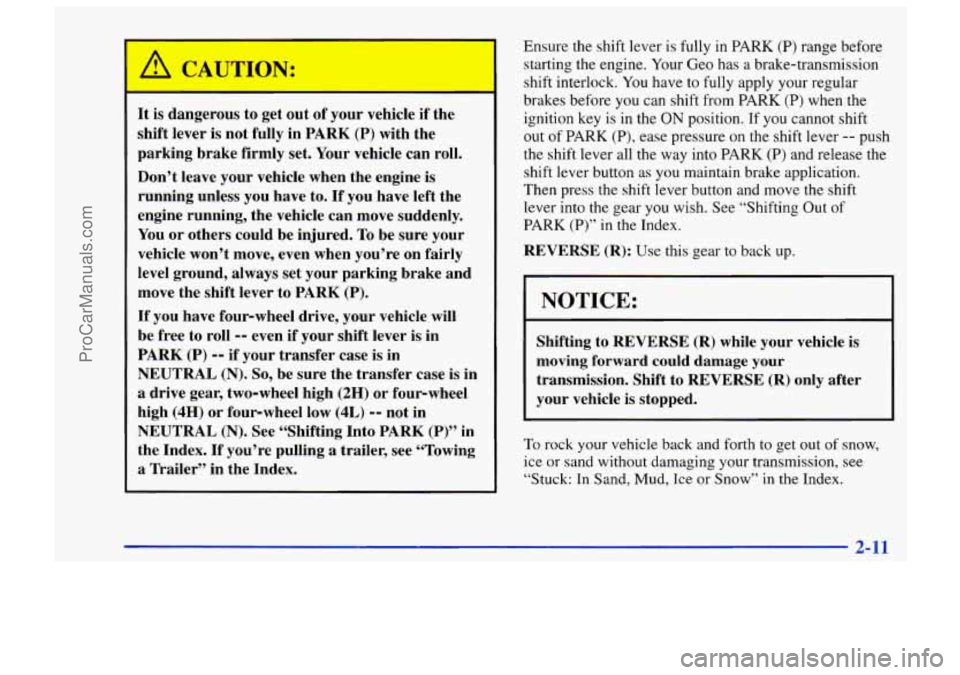
1 A CAUJON:
It is dangerous to get out of your vehicle if the
shift lever is not fully in PARK
(P) with the
parking brake firmly set. Your vehicle can roll.
Don’t leave your vehicle when the engine is
running unless you have to.
If you have left the
engine running, the vehicle can move suddenly.
You or others could be injured.
To be sure your
vehicle won’t move, even when you’re on fairly
level ground, always set your parking brake and
move the shift lever to PARK
(P).
If you have four-wheel drive, your vehicle will
be free to roll
-- even if your shift lever is in
PARK
(P) -- if your transfer case is in
NEUTRAL
(N). So, be sure the transfer case is in
a drive gear, two-wheel high (2H) or four-wheel
high
(4H) or four-wheel low (4L) -- not in
NEUTRAL
(N). See “Shifting Into PARK (P)” in
the Index. If you’re pulling
a trailer, see “Towing
a Trailer” in the Index.
Ensure the shift lever is fully in PARK (P) range before
starting the engine. Your Geo has a brake-transmission
shift interlock.
You have to fully apply your regular
brakes before you can shift from PARK
(P) when the
ignition key
is in the ON position. If you cannot shift
out of PARK
(P), ease pressure on the shift lever -- push
the shift lever all the way into PARK
(P) and release the
shift lever button as you maintain brake application.
Then press the shift lever button and move the shift
lever into the gear you wish. See “Shifting Out of
PARK
(P)” in the Index.
REVERSE (R): Use this gear to back up.
NOTICE:
Shifting to REVERSE (R) while your vehicle is
moving forward could damage your
transmission. Shift to REVERSE (R) only after
your vehicle is stopped.
To rock your vehicle back and forth to get out of snow,
ice or sand without damaging your transmission, see
“Stuck:
In Sand, Mud, Ice or Snow” in the Index.
2-11
,
ProCarManuals.com
Page 66 of 388

NEUTRAL (N): In this position, your engine
doesn’t connect with the wheels.
To restart when you’re
already moving, use
NEUTRAL (N) only. Also, use
NEUTRAL (N) when your vehicle is being towed.
I
Shifting out of PARK (P) or NEUTRAL (N) while
your engine is “racing” (running
at high speed) is
dangerous. Unless your foot is firmly on the
brake pedal, your vehicle could move very
rapidly. You could lose control and hit people or
objects. Don’t
shift out of PARK (P) or
NEUTRAL (N) while your engine is racing.
NOTICE:
Damage to your transmission caused by shifting
out
of PARK (P) or NEUTRAL (N) with the
engine racing isn’t covered by your warranty.
DRIVE (D): This position is for normal driving.
If you need more power for passing, and you’re:
Going less than about 15 mph (25 km/h), push your
0 Going about 15 mph (25 km/h) or more, push your
accelerator pedal
about halfway down.
accelerator pedal all the way down.
You’ll shift down to the next gear and have
more power.
SECOND (2): This position gives you more power but
lower fuel economy. You can use
SECOND (2) on hills.
It can help control your speed
as you go down steep
mountain roads, but then you would also want
to use
your brakes off and on.
NOTICE:
Don’t shift into SECOND (2) unless you are going
slower than
65 mph (105 km/h) with the transfer
case in
FOUR HIGH (4H), or 35 mph (55 km/h)
with the transfer case in FOUR LOW (4L) or you
can damage your transmission.
ProCarManuals.com
Page 67 of 388
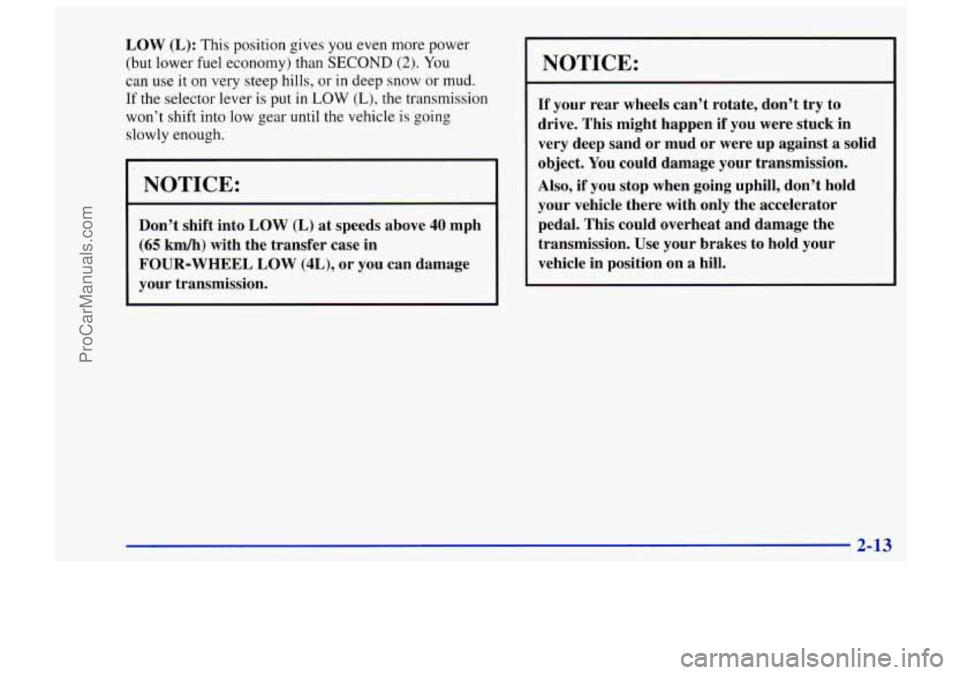
LOW (L): This position gives you even more power
(but lower fuel economy) than
SECOND (2). You
can use it on very steep hills,
or in deep snow or mud.
If the selector lever is put in LOW (L), the transmission
won’t shift into low gear until the vehicle
is going
slowly enough.
NOTICE:
Don’t shift into LOW (L) at speeds above 40 mph
(65 km/h) with the transfer case in
FOUR-WHEEL LOW (4L), or you can damage
your transmission.
I
I
NOTICE:
If your rear wheels can’t rotate, don’t try to
drive. This might happen if yon were stuck in
very deep sand or mud or were up against
a solid
object. You could damage your transmission.
Also, if you stop when going uphill, don’t hold
your vehicle there with only the accelerator
pedal. This could overheat and damage the
transmission. Use your brakes to hold your
vehicle in position on
a hill.
2-13
I
ProCarManuals.com
Page 68 of 388
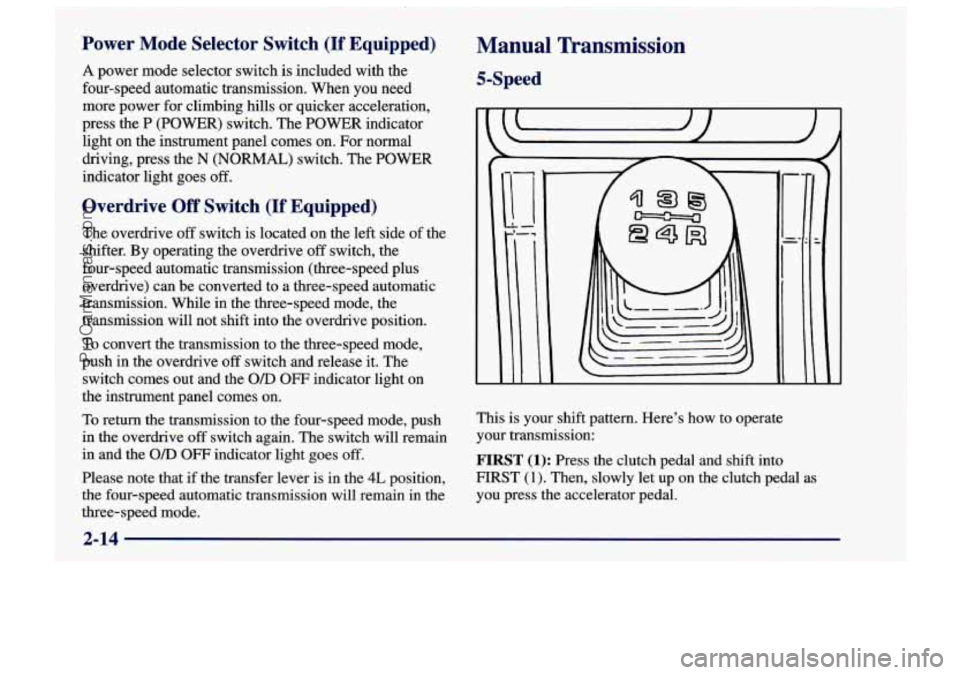
Power Mode Selector Switch (If Equipped)
A power mode selector switch is included with the
four-speed automatic transmission. When
you need
more power for climbing hills or quicker acceleration,
press the P (POWER) switch. The POWER indicator
light on the instrument panel comes on. For normal
driving, press the
N (NORMAL) switch. The POWER
indicator light goes
off.
Overdrive Off Switch (If Equipped)
The overdrive off switch is located on the left side of the
shifter.
By operating the overdrive off switch, the
four-speed automatic transmission (three-speed plus overdrive) can be converted to a three-speed automatic
transmission. While in the three-speed mode, the
transmission will not shift into the overdrive position.
To convert the transmission to the three-speed mode,
push in the overdrive
off switch and release it. The
switch comes out and the
OD OFF indicator light on
the instrument panel comes on.
To return the transmission to the four-speed mode, push
in the overdrive
off switch again. The switch will remain
in and the
OD OFF indicator light goes off.
Please note that if the transfer lever is in the
4L position,
the four-speed automatic transmission will remain in the
three-speed mode.
Manual Transmission
5-Speed
This is your shift pattern. Here's how to operate
your transmission:
FIRST (1): Press the clutch pedal and shift into
mRST
(1). Then, slowly let up on the clutch pedal as
you press the accelerator pedal.
2-14
ProCarManuals.com
Page 69 of 388
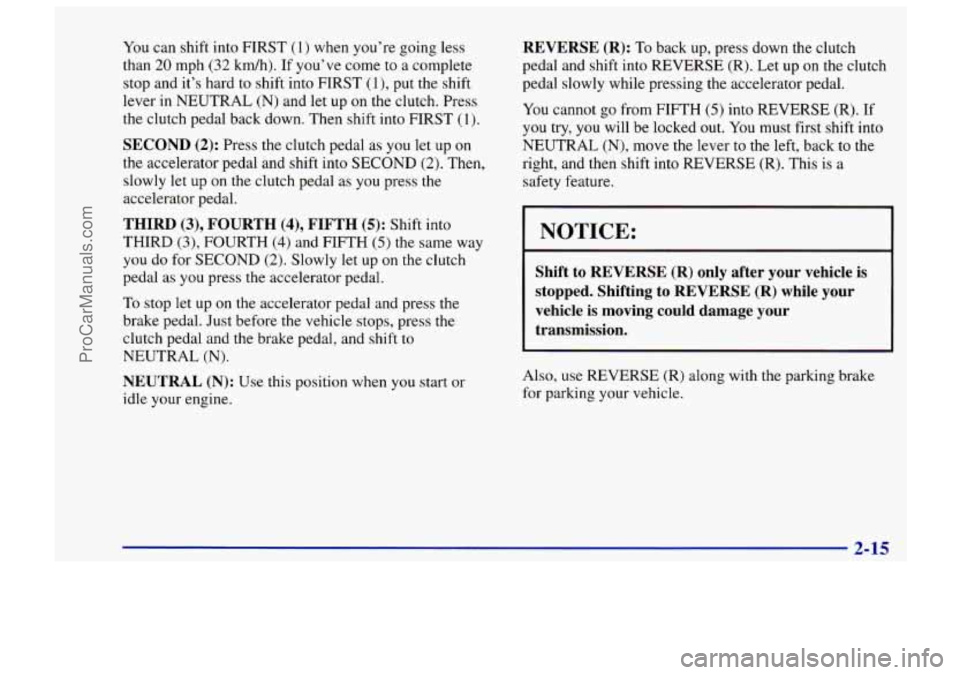
You can shift into FIRST (1) when you’re going less
than
20 mph (32 kdh). If you’ve come to a complete
stop and
it’s hard to shift into FIRST (l), put the shift
lever in NEUTRAL (N) and let up on the clutch. Press
the clutch pedal back down. Then shift into FIRST
(1).
SECOND (2): Press the clutch pedal as you let up on
the accelerator pedal and shift into SECOND (2). Then,
slowly let up on the clutch pedal as you press the
accelerator pedal.
THIRD (3), FOURTH (4), FIFTH (5): Shift into
THIRD
(3), FOURTH (4) and FIFTH (5) the same way
you do for SECOND
(2). Slowly let up on the clutch
pedal as
you press the accelerator pedal.
To stop let up on the accelerator pedal and press the
brake pedal. Just before the vehicle stops, press the
clutch pedal
and the brake pedal, and shift to
NEUTRAL (N).
NEUTRAL (N): Use this position when you start or
idle your engine.
REVERSE (R): To back up, press down the clutch
pedal and shift into REVERSE (R). Let up on the clutch
pedal slowly while pressing the accelerator pedal.
You cannot go from FIFTH
(5) into REVERSE (R). If
you try, you will be locked out. You must first shift into
NEUTRAL (N), move
the lever to the left, back to the
right, and then shift into REVERSE (R). This is a
safety feature.
I NOTICE: 1
Shift to REVERSE (R) only after your vehicle is
stopped. Shifting to REVERSE (R) while your
vehicle is moving could
damage your
transmission.
~~
Also, use REVERSE (R) along with the parking brake
for parking your vehicle.
2-15
ProCarManuals.com
Page 70 of 388
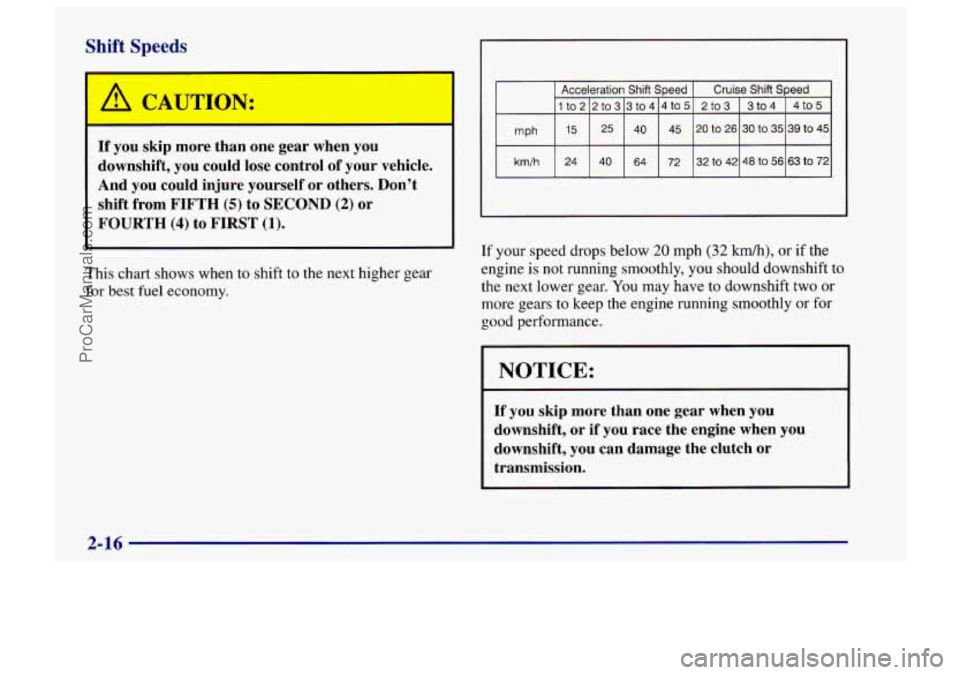
Shift Speeds
I A CAUTION:
If you skip more than one gear when you
downshift, you could lose control of your vehicle.
And you could injure yourself or others. Don’t
shift from
FIFTH (5) to SECOND (2) or
FOURTH (4) to FIRST (1).
This chart shows when to shift to the next higher gear
for best fuel economy.
~ ~~
If your speed drops below 20 mph (32 km/h), or if the
engine is not running smoothly, you should downshift to
the next lower gear.
You may have to downshift two or
more gears
to keep the engine running smoothly or for
good performance.
ICE:
If you skip more than one gear when you
downshift, or if you race the engine when you
downshift, you can damage the clutch
or
transmission.
2-16
ProCarManuals.com